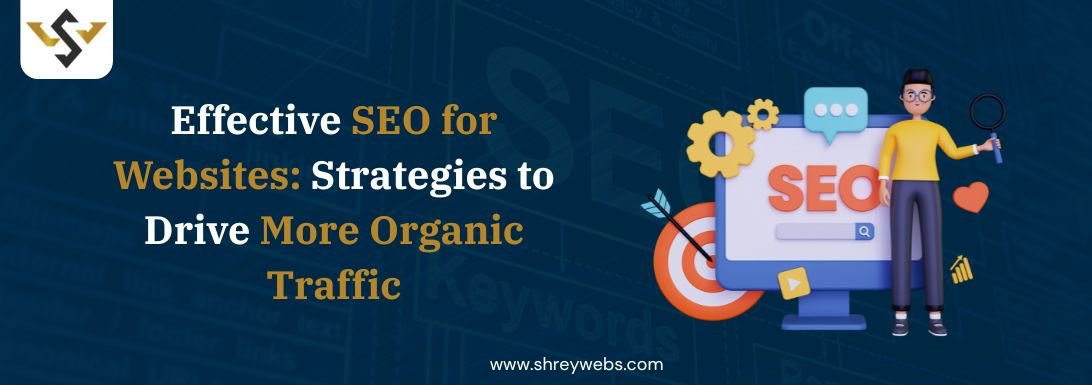In today’s online-centric world, a strong online presence is essential for any organization to succeed. Effective SEO for websites increases the number of people who find you, click on your links, and purchase your products, regardless of whether you operate a blog, an online store, or a local business. Use the right SEO techniques to boost website traffic, and your pages can climb higher in search engine results, meaning fresh visitors show up without you having to pay for ads. This post walks you through practical SEO moves that can increase traffic and lift your overall SEO ranking.
What is SEO for Websites?
Search Engine Optimization, or SEO, is all about making your site easier for search engines like Google, Bing, and Yahoo to read and recommend. The idea is to polish enough pages so they pop up when people type in terms that match what you offer. Good SEO for websites mixes tweaks to content, links from other sites, and snappy back-end code, giving users a smooth ride while gently nudging search robots to trust you.
Why is SEO Important for Boosting Website Traffic?
SEO is important to boost website traffic. When your pages show up high on Google, more curious shoppers notice and click the link. The simple equation is that the more visible you are, the more visitors you welcome.
Good SEO for websites works beyond rankings. It builds a smooth, friendly site where guests linger, browse your services, and become paying customers.
Effective SEO Techniques to Boost Website Traffic
Numerous proven SEO techniques can enhance traffic and elevate page rankings. They discuss well-tuned websites, robust links, and new material. Here are a few of the best actions you can take right now:
1. Keyword Research
Keyword research is the foundation of any SEO strategy. By identifying the keywords your target audience is searching for, you can optimize your website to target those terms.
- Target long-tail keywords: These are longer, more specific keyword phrases that are often less competitive but can drive high-quality traffic.
- Focus on search intent: Understand whether users are looking for information, products, or services, and create content that meets their needs.
- Utilize keyword tools: Tools like Google Keyword Planner, SEMrush, and Ahrefs help identify valuable keywords to target.
2. On-Page SEO
On-page SEO for websites means tweaking each single page on your site so search engines lift it higher in results. These steps can help.
- Optimizing Title Tags and Meta Descriptions: Write punchy, helpful title tags and meta descriptions that include your main keyword.
- Content Optimization: Produce clear, useful, and captivating copy that speaks directly to the reader and weaves in keywords without stuffing.
- Internal Linking: Link related articles and pages within your own site to guide visitors and spread SEO ranking across your domain.
Use of Headers (H1, H2, H3): Split the text into sections with H1, H2, and H3 tags. This makes the piece skimmable for readers and easier for crawlers to read.
3. Off-Page SEO
While on-page work happens inside your site, off-page efforts play out elsewhere on the web.
- Backlink Building: Focus on winning links from trusted blogs, news sites, or industry authorities. Each quality backlink acts like a vote of confidence, boosting your rank and your reputation.
- Social Media Engagement: Keep lively social media profiles that link back to your site. This small step can send fresh visitors your way and make your brand more noticeable.
- Guest Blogging: Pitch guest articles to respected blogs in your field. Along with useful tips, you can tuck in backlinks that steer new readers straight to your page.
4. Technical SEO
Technical SEO involves the technical aspects that enable search engines to properly crawl, index, and rank your site. Some handy tweaks are:
- Website Speed: A sluggish site drives users away and drags down rankings. Compress photos, use caching, and trim the extra code to make pages pop open fast.
- Mobile Optimization: Most users search on phones, so your site must shine there too. Test for responsive design and make sure content loads smoothly, no matter the screen.
- XML Sitemap: Think of an XML sitemap as a special road map for Google. It shows every page, helping bots zip around and index your content without missing anything.
For a deeper dive into these tech fixes, browse ShreyWebs’ Technical SEO services.
How to Increase Organic Traffic and Improve Google Rankings
Growing your website’s organic traffic and improving Google rankings takes time, patience, and steady work. That said, a few clear steps can put you on the right path and keep you moving forward.
1. Focus on Content Quality
Google rewards helpful, trustworthy content. To increase organic traffic, offer articles and pages that genuinely solve problems or entertain.
- Answer user queries: Use free keyword tools to spot common questions your readers ask, then write complete, clear answers.
- Regularly update your content: Google favors updated pages, so review your posts frequently and add the latest facts or stats.
- Use multimedia: Break up text with images, short videos, and handy infographics to keep people reading longer and sharing more.
2. Optimize for Featured Snippets
Featured snippets sit at the very top of some search results and drive traffic to your website. By landing a featured snippet, you can attract a significant number of visitors to your website with just one click.
- Target question-based keywords: Look for phrases that sound like a question, such as “what is” or “how to,” and weave them into your titles.
- Structure content in a way that answers questions clearly: Use short paragraphs, bullets, or numbered lists so your content stands out as an easy-to-read answer.
3. Leverage Local SEO
Utilize local SEO for websites strategies when your website targets a specific geographic area. Optimizing for local search results can help your business increase website traffic from nearby customers.
If your business depends on nearby customers, local SEO becomes a must-have tool. By fine-tuning for local searches, you can increase website traffic and your doorstep.
- Create a Google My Business listing: Claim your free listing and fill it with correct details like address, phone number, and store hours so searchers find you quickly. Be sure to keep it updated whenever something changes.
- Use local keywords: Words like your city name, neighborhood, or even nearby landmarks will help search engines understand where you belong.
- Get local backlinks: Team up with area shops, schools, or charities to earn links back to your site, and watch your online authority grow.
Interested in Local SEO Services? ShreyWebs can show you practical steps to climb local search results.
The Role of Website Traffic Growth and SEO Ranking
Website traffic growth and SEO ranking are interdependent. Fixing site structure, speed, and content nudges your rank up, and a higher rank pulls in even more visitors. Think of it as a friendly feedback loop that never really ends.
Here’s how improving your SEO ranking helps boost website traffic:
- Increased visibility: The moment you move from page two to page one, you steal clicks from competitors. More eyes mean a greater chance someone will actually visit your site.
- Higher engagement: Most people trust the first few results on Google. Once they land on your page, they’re likely to read longer, sign up for newsletters, or buy something. That boost in trust translates to a richer user experience for everyone.
- Sustained traffic: Unlike paid ads, organic traffic builds over time and keeps growing as long as you keep optimizing your site.
Drive Traffic to Your Website with SEO
Put all these tips together, and driving traffic to your website feels much easier. The real trick is to be steady-SEO for websites works best when you treat it like a long-running project, not something you fix once and forget.
- Optimize user experience: Make sure your site loads fast, looks appealing on phones and computers, and lets guests find what they need without frustration.
- Use analytics to track progress: Check tools like Google Analytics or SEMrush often so you can see which pages shine and which ones need a little extra love.
- Iterate and improve: Search rules never sit still. Keep reading about updates and tweak your strategy now and then to protect your rankings and keep the visitors coming.
To learn more about SEO for Hotels, head over to ShreyWebs’ SEO for Hotels page.
Conclusion
Investing in solid SEO for websites is the most effective way to attract consistent, organic traffic and increase your Google rankings. When you blend proven SEO techniques, fresh, helpful content, and fast-loading pages, you set up your website traffic growth over the long term. Yes, SEO takes time and some daily effort, but stick with the plan and soon you’ll enjoy more eyes on your pages, better spots in search results, and wider online reach.
If you would rather leave the heavy lifting to experts and still want to increase website ranking and boost website traffic, think about teaming with a trustworthy agency like ShreyWebs. With years spent boosting sites in fields like SEO for Real Estate, SEO for Automobile, Car Dealer SEO, and SEO for Lawyers, we know what works and can steer your business toward its online goals.
Why wait? Start your SEO journey today and watch your site go from struggling to thriving!

